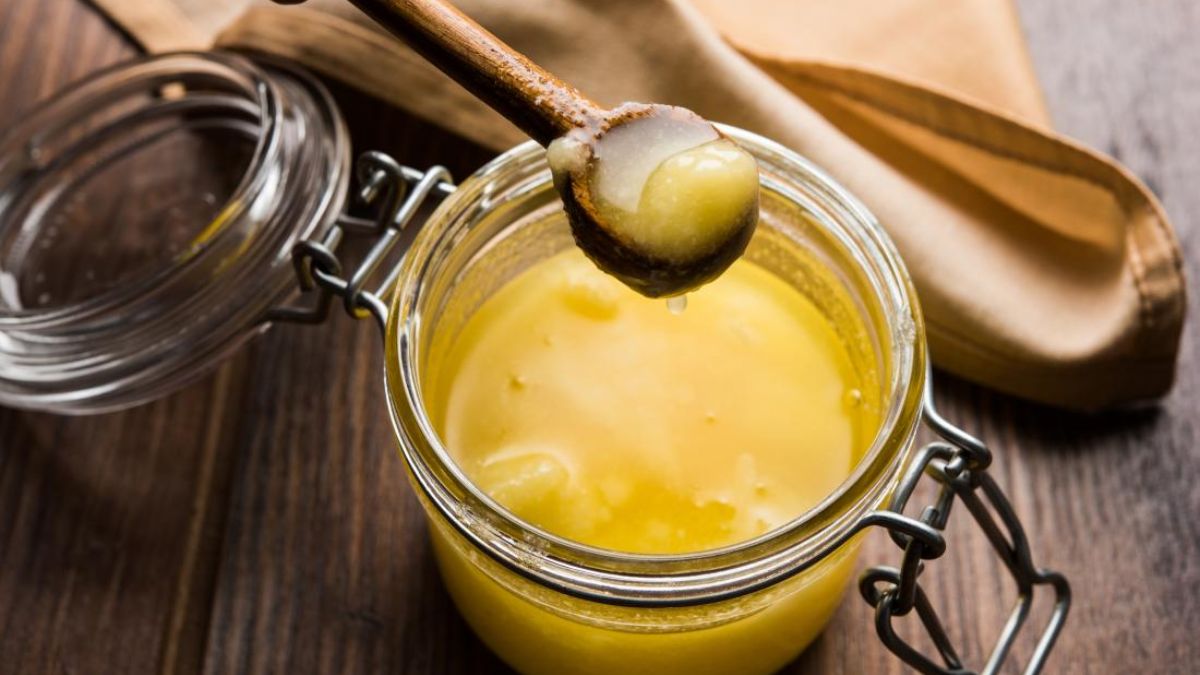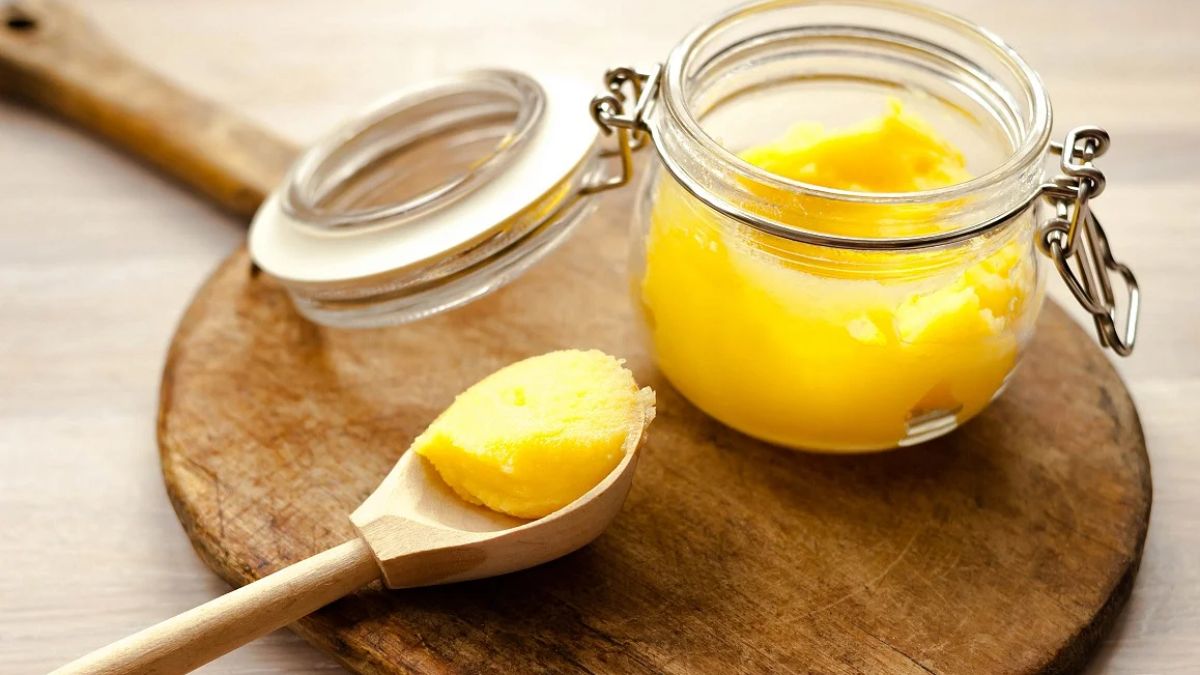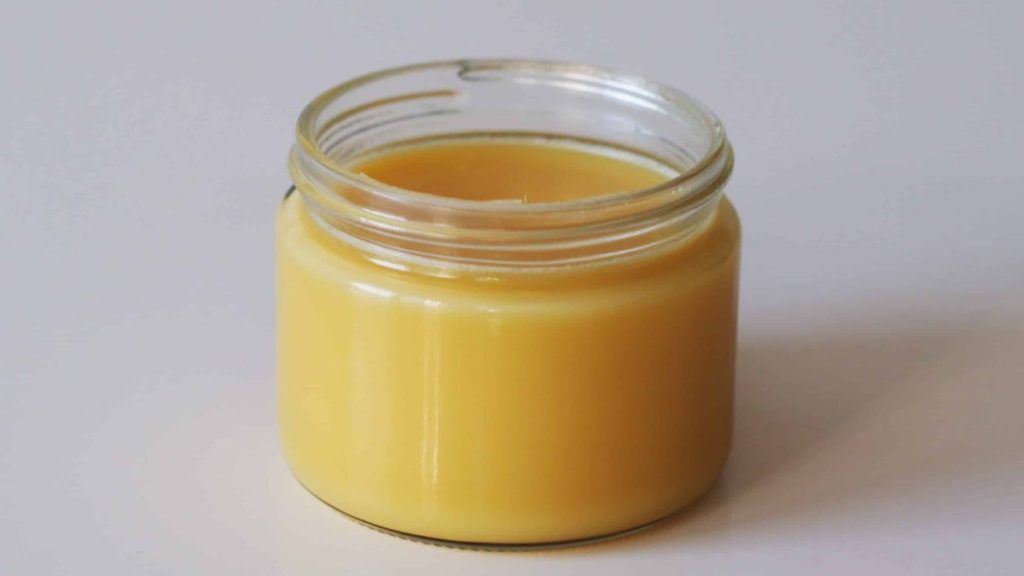Ghee is similar to clarified butter, but there is one difference. Unlike the French method, ghee is usually left to simmer for a while, which browns the milk solids and gives the finished product a slightly nutty taste. It is used in Indian cooking and ayurvedic practices, but any modern American kitchen should have a place for it.
What is Ghee?
Like clarified butter, ghee is made by cooking butter until the water is cooked out and the milk solids and butterfat are separated. The pure butterfat is strained right away and used in its pale golden state in the traditional French method. In the Indian method, the milk solids are caramelized before the butterfat is strained. This gives the ghee a nutty flavor and a darker color.
Ghee is the word in Sanskrit for clarified butter, which is mostly used in Indian cooking. Because this butter is made with heat, it has a distinct toasted flavor called “nutty.” Before commercial vegetable oils, ghee was often used to deep fry food. Unlike butter-based products, they can be smoked and kept for weeks without refrigeration. It is kept in containers that keep air out so it doesn’t go bad quickly.
Traditional ghee is made from the milk of Indian and Pakistani buffalo, but it can also be made from the milk of any other animal that gives milk. The process starts with regular butter, which is made by churning together milk fats, milk solids, and water. This butter still has a lot of water, so it needs to be boiled to get rid of it and make clarified butter.
Pure butter sticks are put in a large pot or kettle on medium to high heat. When the butter melts, the water starts to boil. Solids sink to the bottom, and a thicker layer of oil builds up in the middle. As the extra water boils away, a foamy layer forms on top.
How to Use Ghee?
Ghee is better than butter for cooking with high heat because its smoke point is 450 F, while butter is 350 F. Ghee is the fat that is used most often in Indian cooking. Ghee can be used in place of vegetable oil or coconut oil when baking, sautéing, or deep-frying. Or, you can melt it and spread it on bread for a snack, pour it over popcorn, or drizzle it on vegetables before serving. It can be used in place of butter or oil in most recipes, no matter where they come from.
Ghee is great for high-heat cooking because it doesn’t burn or splash much when it’s cooking. Rub it on vegetables before roasting them, use a dollop for cooking garlic and ginger, or add a spoonful to a hot drink like cider to give yourself a boost of energy in the middle of the morning. Ghee can be used like any other cooking fat, but its rich, grassy flavor comes best when used as a finishing oil. Just be aware that ghee has a taste that is hard to forget.
For Cooking & Food Prep
Ghee has been used in Indian cooking for hundreds of years and is well-known worldwide. Ghee is great for frying, roasting, and sautéing meats, fish, vegetables, and eggs. Ghee can be used in the same ways as butter or cooking oil.
Ghee can be spread on bread and bagels like butter. It can also be used in baking instead of butter or oil. You can put ghee on a baked potato or roasted squash to make it taste better.
For Skin and Hair
Ghee is a natural cooking ingredient that can also be used to make you look better. Because it has a lot of essential fatty acids, ghee is a great way to moisturize and hydrate dry skin. You can also put it on your hair as a mask.
To use ghee on the skin:
- Combine an equal amount of ghee and water to create a paste.
- Apply this paste to the skin for 10-15 minutes.
- Rinse off to enjoy the anti-aging benefits.
You can also put this paste on wounds, burns, or scars to help them heal. A ghee hair mask can help heal split ends, promote hair growth, and relieve dandruff and an itchy scalp.
What does it Taste Like?
Ghee tastes like butter, but it has a background note that is a little roasted and nutty. Like butter, the taste of commercial ghee brands depends on the quality of the milk used to make it. Since the milk solids have been taken out, ghee doesn’t feel as creamy in your mouth as butter. Ghee stays soft at room temperature but gets firm and granular when it gets cold. Ghee tastes richer and nuttier than regular butter. Ghee is thicker and less creamy than butter because the milk solids have been taken out. Most people agree that ghee adds a great buttery taste to food.
Ghee Recipes
You can buy ghee already packaged, or you can make it at home. When butter melts, it splits into three layers. This should only take a few minutes at medium heat, so keep a close eye on it. The top layer foams up, and the milk solids fall to the bottom. Ghee, which is clarified butter, stays in the middle. Start with good, unsalted butter made from the milk of grass-fed cows for the best results.
- Ghee: Clarified Butter
- Moist Banana Bread With Ghee
- Homemade Hollandaise Sauce
Where to Buy Ghee?
If you’d rather buy ghee, you can find it at most natural food stores, health food co-ops, and almost any grocery store. You can find ghee with the cooking oils and shortening or in an Indian food section. Ghee that doesn’t need to be refrigerated can be kept on the shelf.
Storage Tip
Ghee lasts longer than regular butter and can be kept at room temperature for a long time if kept in a container that keeps air out. Please keep it in a cool, dark, and dry cabinet. If heat and liquid are added to ghee incorrectly, it can oxidize or go bad. Oxidation makes it a weird shade of brown, and spoiled ghee smells bad. In either case, the ghee should not be used anymore and should be thrown away.
How is Ghee Made?
To make ghee, regular butter made from cow’s milk is heated until all of the water and milk solids can be strained out. Ghee is the buttery, golden fat left after this heating and straining. Making ghee can take a long time and must only be heated to 100 degrees. This lets many important vitamins and minerals stay in the ghee that would be destroyed by high heat.
Ghee is easy to make at home, and if you keep it in a cool, dry place, it will last very long. Ghee can be kept for up to 9 months in a jar that hasn’t been opened. Once the jar is opened, ghee can last up to 3 months.
Health Benefits of Ghee
Ghee is full of healthy fats, vitamins, and antioxidants. Even though you shouldn’t eat too much fat, studies show that eating fatty foods like ghee can help your body absorb some important vitamins and minerals. Using ghee to cook healthy foods and vegetables may help you absorb more of their nutrients.
Anti-Inflammatory Effects
In Ayurvedic medicine, ghee has been used to treat burns and swelling by putting it on the skin. Even though this isn’t proven by science, ghee has butyrate, a fatty acid known to help reduce inflammation. Studies have found that the butyrate in ghee can help reduce inflammation in the body.
Combat Obesity
CLA, or conjugated linoleic acid, is found in a lot of ghee. Researchers have found that CLA may help fight obesity. Research shows that the CLA in ghee may help stop people from gaining too much weight. Some people may also be able to lose weight because of it.
Support Heart Health
Studies show that eating ghee as part of a healthy, well-balanced diet can help lower unhealthy cholesterol levels. Even though ghee has a lot of fat, it has a lot of monounsaturated Omega-3s. These healthy fatty acids help keep your heart and circulatory system in good shape.
There are many rumors about what ghee can do for you, from helping you lose weight to reducing inflammation. But there is some evidence that ghee is good for your health.
- Ghee may help with obesity, cancer, and heart health because it has a lot of conjugated linoleic acid, a type of fatty acid.
- Everyone is here: It has a lot of vitamins K, A, and E, which help your body do many things.
- Also, ghee may help digestion because it has a lot of short-chain fatty acid butyrate.
Conclusion
Since it comes from animals, ghee is a type of saturated fat. Still, some studies show that it is healthier than traditional Western fats like lard and margarine in the long run. Ghee stays stable without refrigeration because of a natural process, unlike the vegetable oils used in Western cooking, which are hydrogenated or partially hydrogenated. The only thing that should be in basic ghee is unsalted sweet cream butter. Cultured ghee, made from fermented cream, tastes a bit more sour, like yogurt, or spiced ghee, which has extra flavor from garlic, chilies, or herb blends, may also be available.


